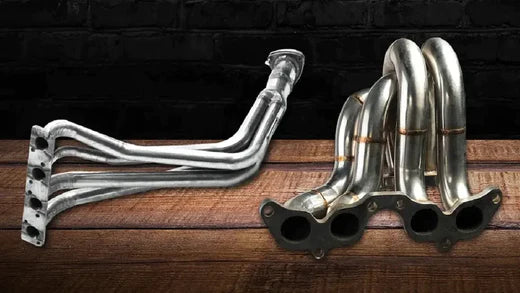
What is an Exhaust Header?
An aftermarket automobile component called an exhaust header is made to enhance performance. For high-performance drivers who frequently modify their cars to go faster, the slight performance boost made possible by an exhaust header is significant. The installation of larger engine intake vents is one of these improvements. An exhaust header modifies the exhaust system to prevent back pressure, which means that less effort is required from the cylinders to push exhaust out than in a conventional system. Depending on the requirements of the drivers, there are many types of exhaust headers, some optimized for low performance and others intended for maximum performance on the open road.
The exhaust from the cylinders is forced into the exhaust manifold in a typical exhaust system, where it travels down the exhaust pipe to exit the vehicle. The cylinder must work harder to push the exhaust out and get ready for the next firing because the exhaust manifold can generate back pressure that presses against the cylinder. As a result, efficiency may be diminished.

Differently, an exhaust header makes a little pipe for each cylinder and directs the exhaust to a much bigger central collector. To ensure that the exhaust gases enter the collector in order when each cylinder fires, the pipes of an exhaust header are bent to fit under the hood and cut to the same length. This solves the back-pressure issue and improves the efficiency of the cylinders.
In some circumstances, an exhaust header can be modified to draw on the subsequent cylinder's exhaust valve and suction the exhaust out, requiring the cylinder to perform even less effort. Low-performance exhaust headers are typically chosen by drivers who want more power for commuting and greater acceleration for hauling large loads. In contrast, high-performance headers are preferred by drivers who want to go quickly.
It's crucial to install the exhaust header made specifically for your automobile because numerous manufacturers produce exhaust headers for an absurdly wide range of vehicles. The exhaust header should be installed carefully or professionally if there is any doubt, as exhaust leaks can be dangerous. An incorrectly placed header may result in an exhaust leak that vents into the car's interior, giving the driver and passengers symptoms of carbon monoxide poisoning.
exhaust manifold in cylinder head
What is an exhaust header gasket?
An exhaust manifold gasket seals the joint between the exhaust manifold and cylinder head. This ensures that all exhaust gas will pass through the catalytic converter for treatment and stops exhaust from leaking out of the connection.
Types of Exhaust Headers
Let's dissect the primary forms of header exhaust to gain a better understanding of them:
- Long-tube headers: These headers include four tubes that combine into one collector, making them appropriate for midrange and low-end torque.
- Shorty headers: Compared to long tube headers, these headers are less noisy. They blend into a single exhaust at a closer distance and are appropriate for higher RPM ranges.
- Lakester headers: These short primary tube heads are common in vintage hot rod vehicles.
-
Tri-Y headers: These headers have a "Y" shape, as you might imagine, to scavenge air. They produce more horsepower than any other type of design.

Exhaust Header Benefits
Perhaps you're still debating whether an exhaust header is worthwhile. With an exhaust header, you'll get the following advantages in addition to the improved horsepower:
- Increased exhaust flow rate
-
sound improvement for your vehicle
- Removing back pressure from your exhaust system
- Which is typically the situation with just an exhaust manifold.
The function of the exhaust header wrap
Header and exhaust pipes can be insulated with radiated heat reduced by using exhaust wrap. Additionally, this boosts exhaust gas temperatures (EGTs), which raises the velocity of the exhaust gas and enhances engine performance. On turbocharged applications, it also aids in reducing turbo lag and spool time.
What's the difference between an exhaust manifold and a header?
Exhaust manifolds and headers differ structurally in terms of their size and substance. Headers are constructed of lighter, thinner steel, while exhaust manifolds are built of heavy, thick iron. Exhaust manifolds are shorter than headers.
Why are there two separate portions for what is essentially the same thing? The primary factor influencing your decision between a header and an exhaust manifold is usage needs.
High-performance vehicles employ headers because they are built, reducing back pressure. As a result, the engine can exhale more readily, producing more power.
Should I use an exhaust manifold or a header?
Which is better for you: a exhaust header or an exhaust manifold? A typical exhaust manifold is the best option for most people. Switching your exhaust manifold for a header won't significantly improve performance if your vehicle isn't a high-performance model.
However, if you're into auto modifications and have a performance engine, adding a header can provide the extra benefit you're looking for.
Do exhaust headers change sound?
As you just learned, installing headers won't increase the volume of your car's sound. It will somewhat alter the sound of your exhaust and slightly enhance performance, but it won't cause your car's exhaust to become louder.
How much do headers cost?
The price of a header is influenced by your engine's cylinder count, your preferred finish, and the brand. We have affordable headers starting at roughly $200 and going all the way up to performance headers costing more than $1,000. Every budget and engine performance enthusiast can find a solution.
